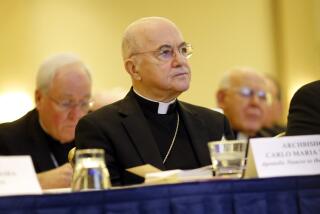Man of Now, Pope of Then
- Share via
IN the beginning of John Paul II’s papacy, it must have seemed as though his luminous faith and exalted position made all things possible. Less than a year after he took office, the pope’s 1979 visit to Poland electrified his countrymen as he exhorted them to stand up to communism.
His continued, passionate messages and the moral and financial support from the Vatican motivated and sustained the Solidarity movement and contributed to the fall of the Soviet Union, a seemingly miraculous triumph for a man who had seen his homeland controlled by the Nazis, then the Soviets.
Though he would have other successes, the pope, who died Saturday at the age of 84, would never be heeded again with quite that level of fervent and unified belief -- even among his fellow Poles. As Parkinson’s disease gained the upper hand during his last four years, it robbed him further of his once-vibrant role as a religious and global leader.
During his 26-year papacy, the third-longest in history, the world changed on many fronts, but the church’s directives on most key issues did not.
The former Karol Jozef Wojtyla took unprecedented steps to heal the divide between Jews and the church, declaring anti-Semitism a sin, establishing relations with Israel and apologizing publicly for Catholics’ indifference to the Jewish plight during the Holocaust. But the divides between liberal and conservative Catholics only widened as the pope did what he was elected to do: maintain doctrinal constancy.
As the Terri Schiavo feeding-tube case turned “culture of life” and “culture of death” into news conference sound bites, few recalled that the pope coined these phrases in his 1995 encyclical, Evangelium Vitae. This Gospel of Life, though, embraced more than the sloganeers imply, saying a culture of life would work to banish violence, endemic disease and deplorable living and working conditions in much of the world.
Affection and Disillusion
Where John Paul II excelled always was in giving the church a popular and charismatic presence. He loved to be among the people, who turned out in hordes worldwide to see the traveling pope who did not cloister himself in the remote Vatican. They thrilled to see him kneel to kiss the earth as he landed in 129 countries, beaming as he touched his followers and kissed their children. His spiritual sincerity was beyond doubt. Polls showed Catholics expressing great affection for their pope and their faith even as in most corners of the world they pulled away from many of its strictures and from Mass.
Wojtyla was a mountaineer, skier, actor, scholar and writer and speaker of eight languages. But as pope he rejected the language of certain modern realities. He dismissed concerns about overpopulation and condemned birth control as an interruption of the “language of love.”
Catholics, meanwhile, followed their own compass. In the United States, more than 80% of Catholics say they have used artificial birth control. Italy, home of the Vatican, has one of the lowest birthrates in the world, even though the pope pleaded with Italians to have more babies. Many Latin American countries, for all the dominance of Catholicism, have among the highest rates of birth control and abortion in the world.
The pope was steadfast on the celibacy of the priesthood, rejection of divorce and refusal to ordain women. He was slow and measured in his response to sexual-abuse scandals involving priests, which angered believers.
Attendance at Mass has dropped precipitously and the proportion of Catholics has remained the same worldwide over more than a decade while other churches have gained, even in Latin America. In most of the world, the number of priests is dwindling alarmingly. Even Poland would disappoint the pope, shaking off communism only to embrace consumerism and accept abortion.
The exception is Africa, where Catholicism is steadily gaining converts. There, the pope’s stances against birth control and condoms are followed -- as the continent loses about 2 million people a year to AIDS and large families struggle to stave off starvation.
Iron in the Velvet
For all his apparent gentleness, the pope brooked little disagreement within the church. He ordered liberal voices to stop writing and teaching and stripped dissenting priests of power and position. He encouraged the Polish church to help bring down communism, then stunned Latin American priests by ordering them to stay out of politics rather than oppose strong-arm regimes. Over his long papacy, he built a hierarchy of like-minded cardinals and bishops in an effort to ensure that the church line would remain unwavering long past his death.
The question that remains after the pope’s death is how long lay Catholics will be content to follow, or quietly ignore, that line -- especially if the next pope does not match John Paul II’s great spiritual charisma and heartfelt desire to, in the final words of the book of Revelation, “be with you all.”
More to Read
Sign up for Essential California
The most important California stories and recommendations in your inbox every morning.
You may occasionally receive promotional content from the Los Angeles Times.










